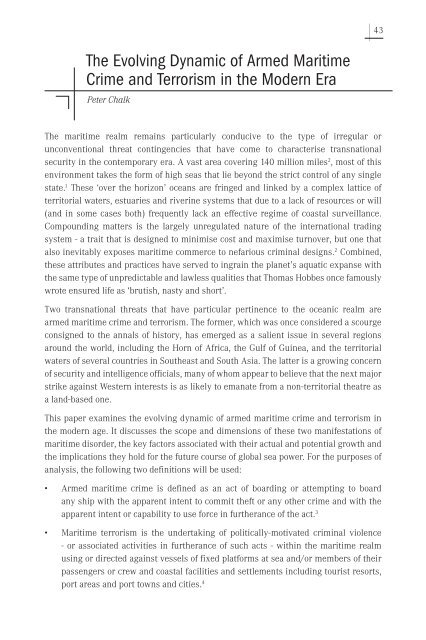THE FUTURE OF SEA POWER
SPC2015_Proceedings
SPC2015_Proceedings
Create successful ePaper yourself
Turn your PDF publications into a flip-book with our unique Google optimized e-Paper software.
| 43<br />
The Evolving Dynamic of Armed Maritime<br />
Crime and Terrorism in the Modern Era<br />
Peter Chalk<br />
port areas and port towns and cities. 4<br />
The maritime realm remains particularly conducive to the type of irregular or<br />
unconventional threat contingencies that have come to characterise transnational<br />
security in the contemporary era. A vast area covering 140 million miles 2 , most of this<br />
environment takes the form of high seas that lie beyond the strict control of any single<br />
state. 1 These ‘over the horizon’ oceans are fringed and linked by a complex lattice of<br />
territorial waters, estuaries and riverine systems that due to a lack of resources or will<br />
(and in some cases both) frequently lack an effective regime of coastal surveillance.<br />
Compounding matters is the largely unregulated nature of the international trading<br />
system - a trait that is designed to minimise cost and maximise turnover, but one that<br />
also inevitably exposes maritime commerce to nefarious criminal designs. 2 Combined,<br />
these attributes and practices have served to ingrain the planet’s aquatic expanse with<br />
the same type of unpredictable and lawless qualities that Thomas Hobbes once famously<br />
wrote ensured life as ‘brutish, nasty and short’.<br />
Two transnational threats that have particular pertinence to the oceanic realm are<br />
armed maritime crime and terrorism. The former, which was once considered a scourge<br />
consigned to the annals of history, has emerged as a salient issue in several regions<br />
around the world, including the Horn of Africa, the Gulf of Guinea, and the territorial<br />
waters of several countries in Southeast and South Asia. The latter is a growing concern<br />
of security and intelligence officials, many of whom appear to believe that the next major<br />
strike against Western interests is as likely to emanate from a non-territorial theatre as<br />
a land-based one.<br />
This paper examines the evolving dynamic of armed maritime crime and terrorism in<br />
the modern age. It discusses the scope and dimensions of these two manifestations of<br />
maritime disorder, the key factors associated with their actual and potential growth and<br />
the implications they hold for the future course of global sea power. For the purposes of<br />
analysis, the following two definitions will be used:<br />
• Armed maritime crime is defined as an act of boarding or attempting to board<br />
any ship with the apparent intent to commit theft or any other crime and with the<br />
apparent intent or capability to use force in furtherance of the act. 3<br />
• Maritime terrorism is the undertaking of politically-motivated criminal violence<br />
- or associated activities in furtherance of such acts - within the maritime realm<br />
using or directed against vessels of fixed platforms at sea and/or members of their<br />
passengers or crew and coastal facilities and settlements including tourist resorts,


